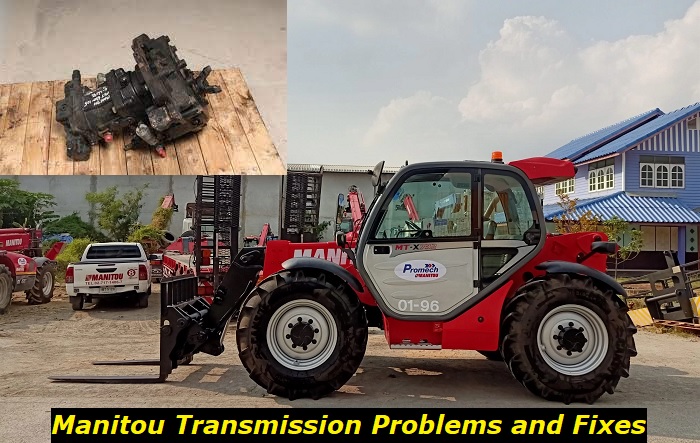Manitou Transmission Problems: Reasons and Possible Fixes
Manitou is a worldwide company specializing in manufacturing and selling material-handling equipment. Their diverse product range includes Telescopic Handlers (Telehandlers), Forklifts, Aerial Work Platforms (AWC), and various Loaders, widely used in agriculture, mining, construction, and logistics.
Yet, for these operations to be successful, the machine's transmission must be in excellent working conditions, as this is necessary for any machine that needs motion and force. The transmission allows the machines to operate at varying speeds and torques, which is essential for different tasks. But transmission systems can suffer problems.

So, in this article, we intend to identify some Manitou transmission problems, the reasons they occur, and how to fix them. Also, we discuss symptoms and preventive measures for Manitou transmission problems.
Transmission Problems in Manitou Machines
The transmission system transfers power from the engine to the wheels and other working parts. Without the transmission system, telehandlers, forklifts, and loaders will not receive the power necessary for locomotion and crucial parts like lifts.
The transmission system includes gears, a clutch, and a shifter. An issue with any transmission part may cause problems for your Manitou equipment. Below we discuss possible problems you may encounter with your Manitou machines.
1) Clutch Problems and Fixes
The clutch is a critical component in the transmission system. It engages and disengages the power transfer between the engine and the drivetrain. The clutch disconnects the engine from the transmission during gear shifts. Without the clutch, the gears in your Manitou can clash and damage the transmission.
In this sense, the clutch allows for smooth shifting and control. Several clutch-related issues can cause transmission issues in a Manitou loader, telehandler, AWC, or forklift, including slippage grabbing and sticking.
Slippage occurs through a failure of the clutch to engage correctly. Slippage will result in power loss or reduced performance. Also, slippage can result from worn-out clutch plates or loose cables.
Grabbing results from abrupt clutch engagement, which will cause jerky movements in your Manitou. Poorly adjusted clutch linkage or the damaged clutch disc can also cause grabbing.
Sticking is a situation where you will not be able to shift the gear easily because of a failure of the clutch to fully disengage. Hydraulic issues can cause bearing sticking problems in your Manitou clutch.
Complete clutch failure is also possible due to wear or hydraulic system failures.
Any repair of a malfunctioning Manitou clutch will involve inspection for visible damage or wear. Depending on the situation, some things you will need to do include: adjusting clutch linkage and cable tension. Also, ensure you have adequate hydraulic fluids in the clutch system.
However, beyond these fundamental clutch issues, you should use an authorized Manitou service center to fix clutch issues in your Manitou telehandler, loader, AWC, or forklift.
2) Torque Converter Problems and Fixes
The torque converter is a significant component for transferring power from the engine to the transmission for Manitou machines. It transfers power to the wheels and other parts that need it. Also, the torque converter allows a Manitou machine to accelerate faster by multiplying engine torque.
Torque converters isolate engines from the load, so they do not have to work as hard when accelerating or decelerating. This isolation improves fuel efficiency. Further, torque converters prevent jerking when gear shifting, by providing a constant flow of power to the transmission.
A torque converter is vital for any Manitou machine, and an issue with it can impact the performance of this equipment. Several things can affect the torque converter of a Manitou machine.
An issue that you need to look out for is fluid contamination or wear. Insufficient transmission fluid can cause poor lubrication and overheating and cause slippage. In addition, a faulty solenoid valve within the torque converter may spell problems for your Manitou. The solenoid valve controls fluid flow and converter engagement. Thus, you may experience erratic gear shifting, slipping, or power loss if it fails.
Damaged internal components like bearings or turbines can also lead to torque converter problems in your Manitou. These components will degrade from normal usage or excessive heat as time passes.
Torque converters are complex components that will be difficult for ordinary users to fix correctly. However, some things you can maintain include regular fluid checks, replacement or top-ups, and filter replacement. Ensure you use the transmission fluid specified by Manitou for your machine. Also, follow Manitou's recommendations for maintaining and servicing torque converter-related parts for your specific machine.
Consult qualified technicians for more complex operations like repairing bearings or turbines.
3) Gearbox Problems and Fixes
The gearbox in a Manitou machine, like a telehandler or backhoe loader, is a transmission system component for changing gears. The gearbox is also known as the transmission. It transmits power from one rotating shaft to another using a series of mesh gears. The gear arrangement helps to multiply the torque output of the engine.
The gearbox allows a Manitou telehandler, loader, AWC, or forklift to change gears. This way, performance is optimized for different conditions. The gearbox allows for speed control, smooth acceleration, and deceleration. It also protects the transmission system from sudden loads and shocks.
A common issue with Manitou gearboxes is transmission fluid inadequacy. Inadequate or contaminated transmission fluid will lead to increased friction, poor lubrication, and excessive heat buildup. These will cause gear slipping, failure, and faster wear.
Also, over time, the gears in the gearbox may wear out with regular usage, heavy loads, or poor shifting techniques. Bad gears in a Manitou could cause grinding noises, shifting difficulty, or gear failure. Improper adjustment of linkages and shift controls can also cause gearbox issues.
The electronic control module (ECM) or unit can also affect gearbox performance. ECMs manage transmission functions in Manitou machines, and problems with it or its sensors can cause incorrect gear selection, poor shifting, and inability to shift gears.
You will need an expert to perform complex and necessary repairs or replacements for your Manitou gearbox to restore the transmission system.
Symptoms Of Manitou Transmission Problems
So far, we have looked at Manitou transmission problems from the perspective of three transmission system components. Some of the symptoms for issues with these components are similar. So, for simplicity's sake and easy identification of a Manitou transmission problem, we will highlight some signs below.
1) Gear Slippage
Gear slippage is a common symptom of transmission system issues, and it can occur with problems in any component of the transmission system. It happens when the gears engage improperly, leading to poor movement or power loss. Should you notice your transmission slips out of gear or erratically shifts, you might have a transmission problem in your Manitou equipment.
2) Gear Grinding
Weird and unusual grinding noises when you shift gears or operate your Manitou are telltale signs of worn-out gears, bearings, or seals. Grinding noises could also indicate improper synchronization or other transmission issues. It could occur when shifting into specific gears or throughout. The unusual sounds could also be a whining or grumbling noise.
3) Leaking Fluid
Leaking transmission fluid is a clear indication that something is wrong. Manitou uses a hydrostatic transmission in its machines. So, hydraulic or transmission fluid is necessary for power transmission, lubrication, cooling, sealing, and corrosion protection. Reddish fluid gathering beneath the machine indicates a transmission system leak. Similarly, a burning smell could indicate the same. Low fluid levels could cause severe damage to your Manitou's transmission.
4) Delayed Or Failed Engagement
A delay in gear engagement after shifting means the transmission is not responding quickly enough. Slow gear engagement will result in lags in acceleration or movement. Even worse, the gears may not engage at all. A problem with the clutch or transmission will stop the gear from engaging and the machine from moving. This is as clear a symptom as you can get regarding a transmission problem.
5) Warning Lights
Recent Manitous should have a dashboard with lights that indicate various malfunctions, including a transmission problem. If you observe such a warning light, your transmission system requires your attention.
Please note that these symptoms can also indicate a problem with a different component of your machine and not just the transmission. Further, these symptoms may vary slightly or widely depending on the type of Manitou machine in your possession and the model. So should you notice any of these symptoms, consult an expert to identify and address the transmission issue correctly.
Preventing Manitou Transmission Problems
While many of the problems regarding Manitou transmission problems might be complex for you, there are some easy maintenance tips you can adopt to prevent them.
- Regularly inspect and change transmission fluid and filter to keep the transmission clean and well-lubricated. Clean and sufficient transmission fluid will prevent wear and tear. Also, replace the fluid filter when it is damaged or clogged.
- Do not overload the machine. Your machine, whether a telehandler, loader, AWC, or forklift, has a rated loading capacity. Don't exceed the machine's loading capacity so you do not overstress the transmission and cause early failure.
- Operate the machine with care. Avoid sudden stops and starts and shift gears smoothly.
- Service the transmission frequently. A qualified technician should inspect your Manitous transmission for symptoms of wear and repair as needed.
Conclusion
Manitou is renowned for its material handling equipment, including telehandlers, forklifts, aerial work platforms, and loaders. Maintaining the transmission system of Manitou machines is crucial for their optimal performance. Knowing the problems and symptoms that can affect them will help. This article identified clutch, torque converter, and gearbox problems affecting Manitou's transmission.
Symptoms of transmission problems you should look out for include gear slippage, grinding noises, and fluid leakage. Also, delayed or failed gear engagement and warning lights are signs of Manitou transmission problems. Regular maintenance, servicing, correct loading, and careful operation can help prevent transmission problems. For complex repairs, consult qualified Manitou technicians.

Add comment